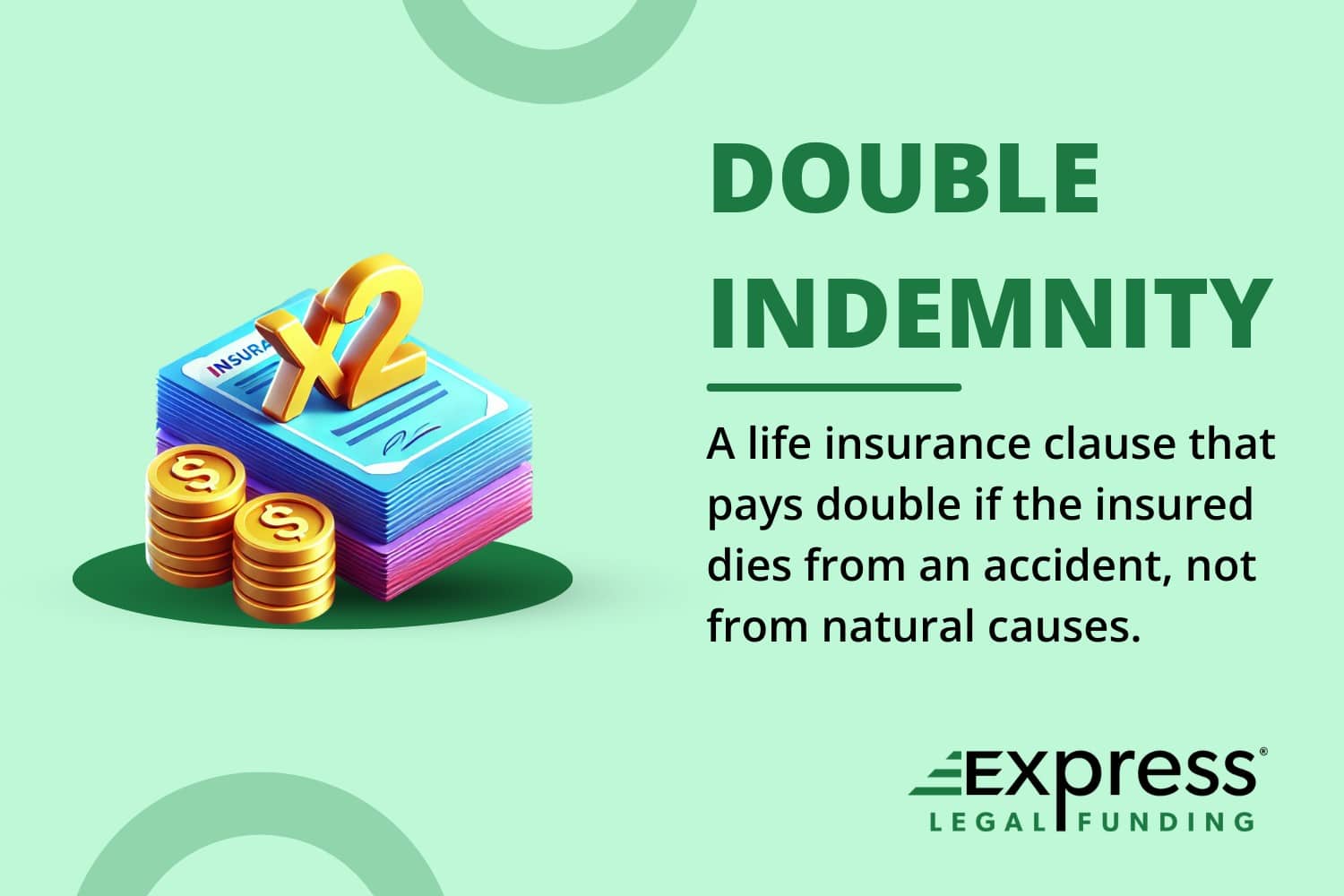What Is Double Indemnity?
Double indemnity is a clause in some life and accident insurance policies that provides a payout of twice the policy’s value if the insured person dies as a result of a qualifying accidental cause. It does not apply to deaths from natural causes, illness, suicide, or situations involving reckless behavior or criminal activity.
Introduced initially to support families affected by workplace accidents and transportation mishaps, it remains a crucial financial safeguard today, especially for individuals in high-risk professions.
This insurance feature gained public attention due to its portrayal in the 1944 film Double Indemnity, which dramatized a murder-for-insurance scam. While the film tells a gripping crime story, double indemnity has been a legitimate insurance provision for over a century.
This guide will explain what double indemnity is, how it works in life insurance, the claims process, and potential challenges in obtaining a payout.
What Does Double Indemnity Mean?

Double Indemnity Definition & Explanation
Double indemnity is a clause found in some life or accident insurance policies that promises to pay twice the standard benefit amount if the policyholder’s death is determined to be accidental. This means the beneficiary would receive double the policy’s value if the death was caused by an unforeseen accident rather than from natural causes, illness, or suicide. In some cases, policies may even include a triple indemnity feature, offering three times the payout under certain high-risk conditions.
However, not all deaths qualify for double indemnity. Insurance providers exclude payouts for deaths resulting from:
- Suicide
- Natural causes (e.g., illness, aging)
- Reckless behavior (e.g., extreme sports, substance abuse, or driving under the influence)
- Criminal activity (e.g., if the policyholder was committing a crime at the time of death)
- Beneficiary involvement (if the beneficiary played a role in the policyholder’s death)
Note: Triple indemnity, while rare, refers to a policy that pays three times the benefit amount for qualifying accidental deaths under very specific terms.
What Is Double Indemnity in Life Insurance?
Double Indemnity Policy vs. Double Indemnity Clause
There are two ways double indemnity can be included in an insurance plan:
1. Double Indemnity Policy
A double indemnity policy is a type of standalone life insurance policy that exclusively covers accidental deaths. Key features include:
- Pays out only for accidental deaths—natural causes, illnesses, and suicides are not covered.
- Common among individuals with high-risk jobs (e.g., construction workers, oil rig workers, and pilots).
- Requires a rigorous investigation to confirm that the death meets the policy’s accident criteria.
2. Double Indemnity Clause
A double indemnity clause is an optional rider added to a standard life insurance policy. It provides an additional payout if the policyholder dies in an accident. Key features include:
- The policy still pays out for all types of death, but double indemnity only applies to accidental deaths.
- More common than standalone double indemnity policies, as it offers flexibility to add extra protection to existing life insurance plans.
- Subject to strict investigation procedures before approval of claims.
Key Differences from Standard Life Insurance
- Higher Payout – Beneficiaries receive double (or even triple) the standard policy amount in cases of accidental death.
- Stricter Eligibility Requirements – Insurers conduct thorough investigations to determine if a death qualifies under double indemnity.
- Exclusions Apply – Not all accidental deaths qualify, and insurers may deny claims under certain conditions.
Because of these strict requirements, homicide investigations and wrongful death lawsuits sometimes involve disputes over double indemnity payouts. Additionally, many employer-provided life insurance policies include double indemnity clauses as part of their benefits package.
Qualifying for a Double Indemnity Benefit
What Is a Double Indemnity Benefit?
A double indemnity benefit is the extra payout provided to a policyholder’s beneficiary if the death meets the insurer’s definition of an accidental death. To qualify, the insurance company must verify that the circumstances of the death meet policy guidelines.
Who can claim the benefit?
- The named life insurance policy beneficiary (e.g., spouse, children, or other dependents).
- In employer-provided policies, the benefit may go to a designated family member or estate.
Common Accidents Covered Under Double Indemnity
For an accidental death to be covered under double indemnity, it must officially be ruled an accident that is covered in the policy. Some examples of accidents covered under double indemnity include:
- Workplace accidents
- Car crashes (unless due to reckless or impaired driving)
- Accidental falls or drownings
- Homicide (if the policyholder was not involved in illegal activity and the beneficiary was not responsible)
- Choking or accidental poisoning
Exclusions & Denied Claims
Insurance companies may deny double indemnity claims for the following reasons:
- Suicide: Most policies exclude self-inflicted harm.
- Preexisting conditions: If the death was caused by a prior medical issue, it may not qualify.
- Reckless behavior: Deaths due to extreme sports, drug overdose, or intoxicated driving are often excluded.
- Criminal activity: If the policyholder was committing a crime at the time of death, benefits may be denied.
- Beneficiary involvement: The claim will typically be denied if the beneficiary is found responsible for causing the policyholder’s death, either through criminal intent or direct involvement.
What to Do If Your Double Indemnity Claim Is Denied
If an insurance company denies your claim, follow these steps:
- Review the denial letter – Identify the specific reason for rejection.
- Gather supporting evidence – Obtain necessary documents like the death certificate, autopsy report, police records, and witness statements.
- File an appeal – Submit a formal appeal with additional evidence to support your claim.
- Seek legal assistance – If the insurer still denies your claim, consider consulting an insurance attorney to dispute the decision in court.
How Long Does Double Indemnity Last?
The duration of double indemnity coverage depends on the type of life insurance policy:
- Permanent Life Insurance (Whole Life, Universal Life): The double indemnity clause remains active indefinitely as long as the policyholder continues paying premiums and does not remove the provision.
- Term Life Insurance: The double indemnity coverage lasts for the policy term. If the policy is renewed or extended, the clause may need to be re-approved by the insurer or purchased again.
- Employer-Provided Life Insurance: Coverage may expire if employment ends, unless the employee can continue the policy independently.
Policyholders should review their policy documents or consult with their insurer to confirm the status of their double indemnity clause and any renewal requirements.
A double indemnity clause stays in effect as long as the life insurance policy is active. If the policy requires renewal, the clause may need to be re-approved or repurchased.
For term life policies, insurers often require a medical exam or an updated risk assessment before re-approving the double indemnity rider during policy renewal.
Permanent life insurance policies typically retain the clause indefinitely unless removed by the policyholder or canceled due to non-payment.
Filing a Double Indemnity Claim
How to File a Double Indemnity Insurance Claim
Filing a double indemnity insurance claim involves a structured process to ensure the insurance company verifies the cause of death and determines eligibility. Follow these steps to submit a claim:
1. Review the Policy
- Check the policy documents to confirm the double indemnity clause applies.
- Ensure that the cause of death falls under covered accidental deaths as per the policy terms.
2. Gather Evidence
- Collect essential documents to support the claim, including:
- Death certificate (stating cause of death)
- Autopsy report or medical examiner’s findings
- Police reports and witness statements (if applicable)
- Toxicology report (if required)
3. Notify the Insurance Company
- Contact the insurance company’s claims department and request a double indemnity claim form.
- Confirm any additional documents required for processing.
4. Submit the Claim Form
- Fill out the double indemnity claim form with the policyholder’s details.
- Attach all supporting documents gathered during the evidence-collection phase.
- Submit the claim via mail, online, or directly through an insurance representative.
5. Await Investigation and Approval
- The insurance company will thoroughly investigate the circumstances of the policyholder’s death.
- If additional documents are required, they may request more proof of accidental death.
6. Appealing a Denied Claim
- If the claim is denied, carefully review the denial letter for the specific reasons.
- If the denial is unjustified, submit an appeal with supporting evidence.
- Consider consulting a legal expert to assist with the appeal if needed.
Claims processing can take anywhere from a few weeks to several months, especially if an investigation is required or reports are delayed.
Challenges in Getting a Double Indemnity Payout
Many insurance companies scrutinize double indemnity claims to limit payouts, often citing policy terms or exclusions. Below are some common challenges and obstacles claimants may face:
- Disputes Over the Cause of Death
- Insurers may argue that the death does not qualify as an accident.
- Inevitable deaths (e.g., car accidents involving speeding or alcohol use) may be contested as reckless behavior rather than accidents.
- Lengthy Investigations
- Insurance companies conduct extensive investigations into accidental deaths, which can delay payouts for weeks or months.
- If law enforcement investigates the death, insurers may await official reports before proceeding.
- Strict Policy Exclusions
- Many policies exclude deaths related to risky activities, such as:
- Extreme sports (skydiving, rock climbing)
- Drug or alcohol-related accidents
- Deaths occurring during illegal activities
- Many policies exclude deaths related to risky activities, such as:
- Toxicology & Medical Reports Delays
- Autopsies and toxicology reports can take weeks to months to finalize.
- Insurers may withhold payouts until they receive these reports.
- Disputes Among Beneficiaries
- If multiple beneficiaries exist, disagreements over who should receive the payout can lead to legal battles and delay distribution.
- The policy may be frozen until disputes are resolved.
- Missed Deadlines
- Some insurance policies require claims to be filed within a specific time frame.
- If a claimant misses the deadline, insurers may deny the claim entirely.
How to Overcome These Challenges
- Read the Policy Carefully – Understand the policy exclusions before filing a claim.
- Consult Legal Help – If facing a denial, an insurance attorney can help challenge the decision.
- Keep Records & Follow Up – Maintain copies of all documents and follow up with the insurer regularly to track claim progress.
By preparing thorough documentation and understanding the common challenges, claimants can successfully improve their chances of securing a double indemnity payout.
Frequently Asked Questions (FAQ) About Double Indemnity
What is double indemnity insurance?
Double indemnity insurance refers to a policy or an add-on to a life insurance policy that provides twice the payout if the policyholder’s death is ruled accidental.
Is double indemnity available in all life insurance policies?
No, double indemnity is not automatically included in standard life insurance policies. It is usually offered as an optional rider for an additional cost.
What happens if a double indemnity claim is disputed?
If a claim is disputed, the insurance company will investigate the circumstances of the death. They may require additional autopsy reports, police reports, or witness statements. The beneficiary can appeal the decision or pursue legal action if the claim is denied.
How does double indemnity affect insurance premiums?
Adding a double indemnity clause increases insurance premiums, providing an enhanced benefit in the event of an accidental death.
Can you add a double indemnity rider to an existing policy?
Some insurers allow existing policyholders to add a double indemnity rider, while others require it to be selected at the time of policy purchase. Approval may depend on age, health condition, and risk factors.
Is a double indemnity payout taxable?
In most cases, life insurance payouts—including double indemnity benefits—are not considered taxable income under federal law. However, exceptions can apply based on the size of the estate, how the benefit is structured, or specific state tax laws. It’s best to consult with a tax professional for personalized guidance.
Summary: Understanding Double Indemnity
Double indemnity is a valuable life insurance feature that provides financial protection by doubling the payout in cases of accidental death. While this clause offers significant benefits, policyholders must carefully review their contracts to understand the specific conditions, exclusions, and requirements set by insurers.
Insurance companies often conduct thorough investigations before approving double indemnity claims, and disputes may arise over what qualifies as an accidental death. Therefore, seeking legal or financial advice before purchasing a policy or filing a claim can be beneficial.
For those considering double indemnity coverage, assessing individual financial needs, risk factors, and policy terms is important. Policyholders can make informed decisions to ensure their loved ones receive the intended benefits and avoid complications when filing a claim.
Need Help After a Denied Insurance Claim?
Understanding double indemnity is just one part of navigating the complexities of life insurance. If you or a loved one are waiting on a delayed or denied claim—especially after an accidental death—financial stress can quickly build up.
That’s where Express Legal Funding can help. We provide pre-settlement funding to plaintiffs in personal injury and wrongful death cases, offering fast, risk-free financial support while you wait for your case to resolve.

